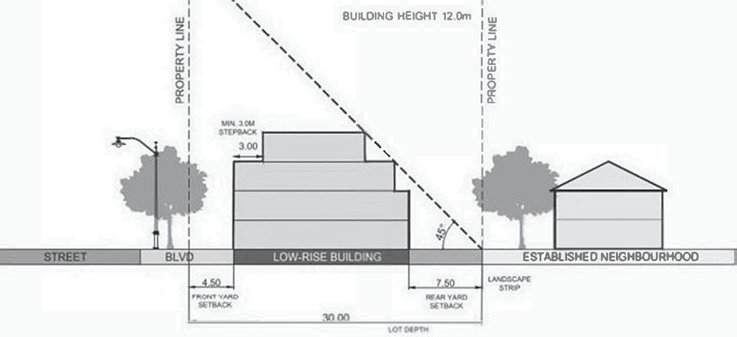
One of the many improvements that the Old Ottawa East Community Association Planning Committee seeks is the re-instatement of the 45° angular plane to step back buildings at the rear so that neighbours’ privacy and light is better protected, and trees can thrive. Image Supplied
John Dance
Old Ottawa East (OOE) and other core communities face unprecedented planning and development challenges in the face of the City’s new Official Plan and the provincial government’s goal to increase housing supply through the controversial More Homes Built Faster Act.
Sitting in the crosshairs of the challenges is the OOE Secondary Plan (OOESP or the Secondary Plan), a City Council approved document that establishes goals and constraints for development within the community. While the OOESP has ambitious targets for new housing in specific areas, it also seeks to respect existing neighbourhood character and to enhance the sustainability of the community. The decade-old OOESP was developed over four years through a collaborative process involving community members, the Old Ottawa East Community Association (OOECA), City staff and the large institutional landowners.
An example of the potential impact on OOE is that, in a developer’s eyes, Main Street south of Clegg Street could have nine-storey buildings as a result of the new provincial housing legislation. Yet the Secondary Plan policies limit heights to four-storeys because it’s a “neighbourhood low-rise designation.” Another example is the proposed 18 Hawthorne Avenue development, where the provincial legislation permits six storeys even though current zoning allows just four.
The Secondary Plan has an overriding provision that no buildings may be more than six-storeys except in certain delineated areas in the interior part of Greystone Village. But this provision is not likely to deter developers from seeking the more generous provincial limit.
Density Targets
As the OOECA Planning Committee recently outlined in a meeting with Capital Ward Councillor Shawn Menard, “The density target for the institutional lands is already exceeded by approvals to date, and what’s pending may result in twice the number of dwelling units targeted by the OOESP. Secondly, City analysis of new proposals in the area tend to focus on just the proposal at hand rather than assessing cumulative impacts of traffic and parking requirements and the impact on the OOE tree canopy.”
A specific example is the proposal for 284 units on the eastern half of the Sacre Coeur property (15 des Oblats Avenue) which made no provision for residents’ parking and had no analysis of impacts on neighbouring streets. “We see no evidence that a road network designed for 1000 units can accommodate 50 percent more traffic,” the Planning Committee commented.
The Secondary Plan set a dwelling unit target of 150 for all of Hawthorne Avenue yet the 18 Hawthorne Avenue proposal would have 67 units constituting 45 percent of the target even though this building would occupy only 17 percent of the “developable” street frontage.
Conversely, the Planning Committee says the City has failed to ensure that the targets for much greater density around the Lees LRT station are actually met. The University of Ottawa is now building a six-storey building there even though the zoning allows 30-storeys. Had the university reached out to developers, many dwelling units could have been constructed above the medical sciences building, thus reducing pressure to build elsewhere in OOE and Sandy Hill.
“We recognize that densification is a reality. But it must be done wisely, targeted to areas like the Lees LRT station and consistent with the policies of the OOESP,” says Dianne Caldbick, a member of the OOECA Planning Committee.
Size of Required Yards
It’s not just the large developments that pose challenges to the built fabric of OOE. Over the last few years, there have been increased pressures to seek minor variances and zoning by-law amendments that reduce the size of rear yards and the “setback” between the rear face of a building and the rear lot line, and amendments that alter the streetscape character of neighbourhoods. Many of these minor variances have been approved by the City-appointed Committee of Adjustment, despite clear violation of OOESP policies and objections raised by the OOECA Planning Committee.
“Reduced rear yard setbacks invariably reduce: landscaped amenity space; volume of critical root zone and ability for a mature tree(s) to flourish; appropriate rear separation distances between existing and new homes; reasonable privacy from overlook; and, depending on building height and orientation, the desire for some rear yard sunlight and sky view,” the Planning Committee told Councillor Menard.
Although the new Official Plan seeks to increase the City’s tree canopy, recent and proposed developments in Old Ottawa East will result in a decreased tree canopy with many trees being removed and others being replaced by species that will not become large canopy trees.
In May 2022, as a “housekeeping”
amendment to the Low-rise Infill Guidelines, the City eliminated the 45° angular plane restraint guidance – “an upward angle drawn from the edge of a [rear] residential lot line to define the confines in which to build to protect a neighbour’s access to light and sun.” Like reduced rear yard setbacks, this action by the City will adversely affect residents’ enjoyment of their rear yards, privacy and tree growth.
New Zoning By-law
The OOESP has several unique features including a policy to maintain existing zoning in the residential neighbourhoods. In the face of the City undertaking a complete revamp of its zoning by-law, unclear how the existing zoning by-law provisions will fare. A related example is that the OOESP has a specific provision that aims to “Maintain the traditional pattern of pedestrian priority along the street with any garages relegated to the side or rear of homes and not projecting forward or otherwise dominating the building façade.”
A key aspect of the new zoning by-law is that the focus will be on the “form” of new buildings – not on what’s in them. Thus, rather than single-family dwellings in much of the community, there will be new regulations permitting duplexes, triplexes, coach houses and other variations. Maintaining provisions such as current yard setbacks and heights may be a challenge in light of increased densification. Residents can participate in the development of the new zoning by-law by completing the surveys at https://engage.ottawa.ca/zoning/news_feed/new-zoning-by-law-discussionpapers-march.
A number of other planning and zoning questions also require discussion, including: will the City appeal minor variances, given community associations and other third parties are no longer allowed to do so?; how can the pre-application consultation process be improved?; and, are the land use designations and zoning for the areas near the northwest part of the Highway 417-Nicholas Street interchange reasonable?
The OOECA Planning Committee has met with Councillor Menard on these issues, and he is arranging a meeting with City staff so that OOECA can have meaningful consultation and discussions, in an effort to bring clarity to the OOESP policies’ intent.
Editor’s Note: John Dance is chair of the Old Ottawa East Community Association’s Planning Committee.






